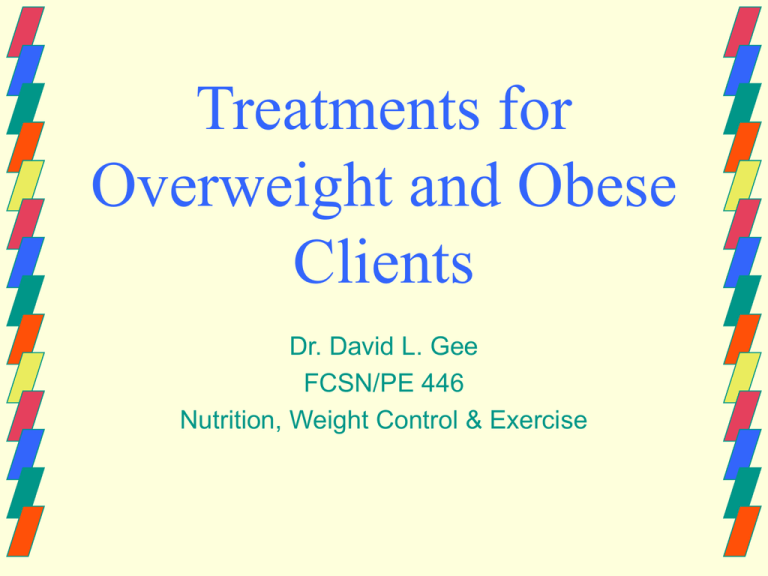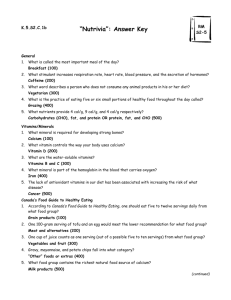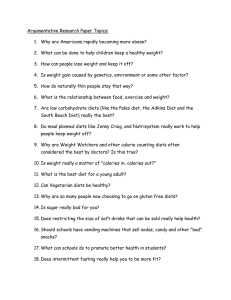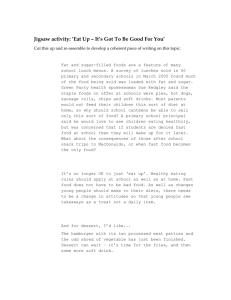Treatments for Overweight and Obese Clients
advertisement

Treatments for Overweight and Obese Clients Dr. David L. Gee FCSN/PE 446 Nutrition, Weight Control & Exercise Assessment of Healthy Weight • Body Mass Index (>25) • Risk factors for chronic disease – High waist circumference – blood pressure (hypertension) – blood lipids (dyslipidemia) • TC, LDL-C, HDL-C, TG – Impaired glucose tolerance – family history • Presence of obesity related disease The Bottom Line on Weight Control • Regardless of the characteristics of a weight loss program: • Negative Energy Balance – Results in weight loss – E(in) is less than E(out) • Positive Energy Balance – Results in weight gain – E(in) is greater than E(out) • Energy Balance – Results in weight maintenance – E(in) is equal to E(out) Treatment Affecting Energy Intake • Listed from low to high risk • Healthy diet approach (w/BM) • Balanced hypocaloric diet (w/BM) – Low Calorie Diet (LCD) • Drugs • Very Low Calorie Diets • Gastric & Intestinal Surgery Treatment Affecting Energy Expenditure & Losses • • • • Increase lifestyle activity Aerobic exercise (w/BM) Strength training (w/BM) Drugs (no prescription drugs currently approved) National Weight Control Registry (University of Colorado) • ~3000 people • kept >30 lbs off > 1year – average BMI 35 => 25 – Average lost 60 lbs, kept it off for 5 years • many were overweight as children (2/3), had one or both parents overweight (60%) • average age 45 yrs • http://www.uchsc.edu/nutrition/WyattJortberg/nwcr.htm Seven Tips from the National Weight Control Registry CNN – “Fat Chance”, Nov 2003 • Expect failures but keep trying –Don’t view past failures as signs you can’t succeed • Don’t deny yourself –Plan indulgences • Weigh yourself regularly Seven Tips from the National Weight Control Registry CNN – “Fat Chance”, Nov 2003 • Exercise regularly –Walking most popular • Add a little bit of exercise to your daily activity • Eat a high CHO/low fat diet • Eat 5 meals a day Other Tips from the National Weight Control Registry • • • • No pain, no loss Make smaller lifestyle goals Exercise & Diet (90%) Do what you want, not what you should. Major Dietary Approaches For Weight Loss • Healthy Diet/Non-Diet Approach – DASH, Food Guide Pyramid • Balanced Reduced (Hypocaloric) Diet – Weight Watchers, Jenny Craig, Slim Fast • Low Carbohydrate Diet – Dr. Atkins • Restrained Carbohydrate Diet – South Beach Diet, Zone Diet Treatments for the Overweight Patient (BMI 25-30) The Non-Diet or Healthy Diet Approach • Focus on becoming healthy • Success is measured in “units of health”, not units of weight • Strategies are lifetime, not temporary • Make a commitment because you want to, not because you have too. Dietary Modification for the Overweight Patient • Focus first on the quality of the diet, second on the quantity. – Food Guide Pyramid – Dietary Guidelines for Americans – DASH diet • www.nhlbi.nih.gov – Focus on fruits, vegetables and whole grains Food Guide Pyramid (the New Food Pyramid has different pyramids based on energy needs) Energy Intake Grain 1600 kcal 2200 kcal 2800 kcal 6 9 11 Vegetable 3 4 5 Fruit 2 3 4 Meat (oz) 5 6 7 Fat (g) 53 73 93 Added sugar (tsp) 6 12 18 Portion distortion Healthy Diet Effects • Healthy diet may or may not result in weight loss – if weight loss occurs, it will be gradual • Healthy diet should result in improved health • Improved health may require more significant weight loss • A healthy diet is probably the best diet for long-term weight maintenance Final Exam – 2005 Required Readings • NIH – Clinical Guidelines • WIN Publications (Weight Information Network) – – – – – Statistics Weight Cycling Very Low Calorie Diets Surgical Treatments for Obesity Pharmacological Treatments for Obesity • Nutrition Club – Tuesday, 5:30PM, 126 Mich – 2005-06 officer elections – Salmon BBQ Balanced Hypocaloric Diet • “Low Calorie Diet” – LCD, not VLCD • For those who are : –significantly overweight • BMI >25 w/ health risks –can not attain good health without significant weight loss Balanced Hypocaloric Diet • Negative energy balance – Energy In < Energy Out • -500 Cal/day energy balance = 1 lb fat/week weight loss • -EB achieved with COMBINED – dietary caloric restriction – increased exercise – plan a net -EB of -500-1000 Cal/day Negative EB is Accumulative • If EB = - 200 Cal/day – decrease food by 100 Cal/day – increase activity by 100 Cal/day • • • • In one month EB = - 6000 Cal at 3500 Cal / lb FAT => almost 2 pounds per month over 20 pound per year weight loss Composition of Balanced Hypocaloric Diets • Calories –reduce intake by about 500 Cal/d –minimum of 1000 Cal/d • Estimate calories –Calculate energy expenditure –Food records Composition of Balanced Hypocaloric Diets • Low Fat – < 25% of calories • Moderately high in complex CHO – ~ 60% of calories – Unless pt w/ hypertriglyceridemia • Reduce CHO 45-50% of calories • Fat 30-35%, mainly unsaturated fats • Adequate in proteins – > 0.8 gP/kg BW Forms of Balanced Hypocaloric Diets • Meal Plans – Dietary exchanges • Weight Watchers – Commercial Diet Packages • Jenny Craig • NutriSystems – Food Supplement/Food Combos • Slim Fast Metabolic and Weight Loss Effects of Long-term Dietary Intervention in Obese Patients: Four-year Results Flechtner-Mors M, et al. Obes Res. 2000;8:399-402. • Randomized controlled trial – 75 subjects followed for 4 yrs – Control vs Slim-Fast program • Wt loss at 4 yrs – Control: 3.2% SF: 8.4% • Fasting blood glucose at 4yrs – Control: 13% lower SF:12% (ns) – Similar findings with fasting insulin • Systolic and fasting TG lower in SF group Advantages of Balance Hypocaloric Diets • Safe • High quality weight loss • More similar as a “Diet for a lifetime” • Large volume of food • No elimination of any food or food group Disadvantages of Balanced Hypocaloric Diet • Another “diet” –going on, going off • Slow rate of weight loss –think long term • No “magic”, no gimmick Final Exam – 2004 • Exam Format (see 2003 Study Guide linked on course web page) – No questions on Ergogenic Aids ! – Short answer/essay • Hypothetical case study – Data on height, weight, risk factors – Do assessment, establish weight goal – Common questions a client might ask – MC/TF • Information that you might be asked from clients and health professionals • Research studies presented are to reinforce and confirm relationships between obesity, weight loss and disease risk. Dietary Means to a Healthy Weight Low Carbohydrate Diets • Characteristics – Very low in CHO • Induction phase: < 20g/d • Maintenance phase: 40-60g/d – Restricted intakes of fruit, cereals, pasta, bread, potatoes, rice – Caloric intake not specified • Examples – Atkins diet The High Protein/Low Carbohydrate Diets: Rationale: The high CHO/insulin link • The Claim: –High CHO diets result in hyperinsulinemia –Insulin stimulates fat synthesis –therefore high CHO diets result in gaining fat weight The High Protein/Low Carbohydrate Diets: Flaws in Rationale • The Reality: • Hyperinsulinemia is a result, not a cause, of obesity • Although insulin does stimulate fat synthesis: – fat synthesis only occurs with +Energy Balance – fat synthesis from CHO is inefficient and with +EB, body preferentially stores excess dietary fat as body fat Carbohydrate intake and biomarkers of glycemic control among US adults: NHANES III AJCN 77:1426-1433 (2003) • 5730 men, 6125 women – Cross-sectional NHANES III study • Divided into quintiles based on % CHO calories • No association between CHO intake and: – HB A1c concentration – Fasting plasma glucose – Fasting serum insulin • “this supports current recommendations regarding carbohydrate intake in healthy adults.” • (also note international epidemiological studies) The High Protein/Low Carbohydrate Diets: Rationale: Epidemiological Evidence • The Claim: – Since the 1950’s % FAT has fallen from about 40% to about 34% – Since the 1960’s the % obese has risen from 25% to about 33% • Therefore, hi CHO diets have contributed to the increase in weight problems The High Protein/Low Carbohydrate Diets: Flaws in Epidemiological Evidence • The Reality: – Studies show that despite an increase in %CHO in diet, there is increasing obesity. – But, while %CHO increased & %FAT decreased – TOTAL Calories increased – caloric expenditure decreased – absolute fat intake stayed the same. The High Protein/Low Carbohydrate Diets: Realities • Diets low in carbohydrate will deplete glycogen stores – result in significant early water loss – cause premature fatigue during exercise The High Protein/Low Carbohydrate Diets: Realities • High protein diets will result in further weight loss if Ein < Eout – meat, cheese, egg diets become unappetizing over the long run – long-term compliance to this restricted diet is likely to be poor • Diets high in meat … are high in saturated fats and may increase risk of heart disease. – Short term (during active weight loss) may see improvement in blood lipids The High Protein/Low Carbohydrate Diets: Realities • Low Carbohydrate diets will result in ketosis – most cases degree of ketosis are mild – most cases there is some appetite suppression – in some cases, there will be ketoacidosis and electrolyte imbalance - need for physician supervision The High Protein/Low Carbohydrate Diets: Conclusions • High protein diets will result in short term weight loss • Long term effectiveness is very questionable • Long term effect on health is a concern A Randomized Trial of a LowCarbohydrate Diet for Obesity. Foster et al. NEJM 348:2082-90 (2003) • 66 obese men and women (BMI=34) • Randomly assigned to diets for 1 year • Professional contact minimal to replicate approach used by most dieters Weight loss (%BW loss) • 3 months • Low fat: • Low cho: 2.7% 6.8% (p=0.001) • 6 months • Low fat: • Low cho: 3.2% 7.0% (p=0.02) • 12 months • Low fat: • Low cho: 2.5% 4.4% (ns) Changes in risk factors • Improved in low CHO diet groups – Serum Triglycerides – HDL-cholesterol • No difference between low CHO and low Fat diet groups – Blood pressure (ns) – LDL-cholesterol • NS (but lower in low fat at 3 mo., mean lower at 12 months) – Insulin sensitivity (ns) • Drop-out rate: – Low fat: – Low cho: 43% 39% • Reported adverse reactions higher in Low CHO group – GI problems (diarrhea/constipation) – Bad breath – Fatigue/weakness – headache Low-Carb Diets Summary of Long-term studies • What the research shows: – Short-term outcomes • 6 month studies – – – – Better weight loss Improved plasma TG and HDL-C drop-out rate significant in both LC and LF Adverse effects greater in LC – Long-term outcomes • 1 year studies – – – – weight loss no better than low fat group still improved plasma TG and HDL-C drop out rate significant in both groups LC eating more CHO than recommended, low SFA, high MUFA – LF eating more FAT than recommended Dietary Means to a Healthy Weight The Carbohydrate ‘Restrained’ Diets • Characteristics • Lower in CHO than Dietary Guidelines but higher than Low Carb diets (~40% CHO, 30%FAT, 30%PRO) • Low glycemic index foods encouraged • Monounsaturated fats encouraged • Examples – Zone Diet, South Beach Diet • What the research shows: – Little research available on these diets Very Low Calorie Diets VLCDs • Characteristics – 400-800 Cal/d – Generally semi-synthetic beverages – ‘high protein’ (50-100g/d) – Very low fat – Low to moderate CHO – Expensive Very Low Calorie Diets VLCDs • Must be Medically Supervised – Generally safe • Minor side effects – – – – Fatigue Constipation or diarrhea Nausea/dizziness Cold intolerance • Possible significant side effects – Gall stones – Electrolyte imbalances Very Low Calorie Diets VLCDs • Patient Criteria – BMI > 30 – BMI= 27-30 with medical complications • Contraindications – Pregnancy – Children – history of • dysrhythmia of heart • gall stones • renal dysfunction Very Low Calorie Diets VLCDs • Short term outcome – Rapid high quality weight loss • 30-35 kg in 25 weeks – Reduction in health risks • Long term success – No more (or less) successful than other treatments – Maintenance program (diet, behavior, exercise) critical for success Guidelines for Identifying Weight Loss Fraud • Claims easy, large, fast weight loss • eat all you want, no exercise • uses quackery terms • gets rid of “cellulite” • relies on undocumented cases Guidelines for Identifying Weight Loss Fraud • Claims government approval • gives no or incomplete scientific references • cures everything • promotes use of unproven aids/gadgets – equipment – supplements Guidelines for Identifying Weight Loss Fraud • Makes claims about “problems associated with combining certain foods in the same meal” • Describes diet as being opposed by the the established medical community • Distributed exclusively by mail order, internet, 800 phone, pyramid sales organization Remaining Fall 2002 Schedule • 12/2 – Hi PRO/low CHO diets – VLCD – see web notes and WIN web reading – Exercise and weight loss – BM/assessment assignment due • Turn in: – your BM records – SOAP notes for your client • 12/4 – Pharmacological approaches to weight loss • 12/6 – Surgical methods for weight loss • 12/13 – 8:30-10 – Final Exam RCT – Atkin’s Diet E. Westman, Duke Univ. presented at 2002 AHA annual meeting • Funded by R. Atkins Foundation • 120 overweight subjects – Randomized • Atkins diet • AHA step 1 diet (US Dietary Guidelines) – 6 months RCT – Atkin’s Diet What does this mean? • Greater adherence due to novelty? – ADA step 1 diet not much different than typical diet • Don’t ignore 100’s of studies of CHD dangers of high SFA/chol diets – Based primarily on stable weight • This is a short term study – Long term weight loss success – Effect of weight maintenance on blood lipids • Provocative, but…wait and see! Extra Credit Opportunity • Replaces the 25pt Eating Behaviors Project • Worth 5 extra credit points • Write a 2+ page commentary on the USA Today article: – Kids need school's help to get healthy • http://www.usatoday.com/news/health/2003-05-19-fitkidsusat_x.htm • To get all 5 points, your commentary must be: – – – – Thoughtful (and realistic) Well organized Well written typed Characteristics of a Healthy Diet • Low Fat, Low Saturated Fat – reduces CHD, Hpt, cancer risks – lowers caloric density and may reduce food intake • reducing dietary fat alone without reducing calories is insufficient Characteristics of a Healthy Diet • High in Fiber – reduces CHD & cancer risks – reduces caloric density • Low in Sugar – reduces caloric density – often associated with high fat foods Characteristics of a Healthy Diet • Moderation in salt and alcohol – reduces hpt, CHD, cancer risks – alcoholic beverages high caloric density Findings RCT – Atkin’s Diet • Atkins Diet – – – – Wt loss = 31 lbs LDL-C = no change TG = 49% drop HDL-C = 11% increase – Fewer drop-outs • AHA step 1 diet – – – – Wt loss = 20 lbs LDL-C = no change TG = 22% drop HDL-C = unchanged A Low-Carbohydrate as Compared with a Low-fat Diet in Severe Obesity. Samaha et al. NEJM 348:2074-81(2003) • 132 severely obese (BMI=43) • Randomly assigned to low-CHO or lowFat diets for six months • Weight loss at 6 months: – Low-fat: 1.9kg – Low-CHO: 5.8kg • Triglyceride change – Low fat: – Low cho: -7mg/dl -38 mg/dl (p<.001) • LDL-C – Low fat: – Low cho: + 3mg/dl + 5mg/dl (ns) • HDL-C – Low fat: – Low cho - 1mg/dl 0 mg/dl (ns) • Hemoglobin A1c – Low fat: – Low cho: 0% -0.6% (p=.06) • Dietary changes – Caloric intake • Low fat: • Low cho: -271 Cal/day -460 Cal/day (ns) – Fat intake (% of calories) • Low fat: • Low cho: 33% to 33% 33% to 41% (p<.001) • Drop-out rate at 6 months – Low fat: – Low cho: 47% 33% (ns)







